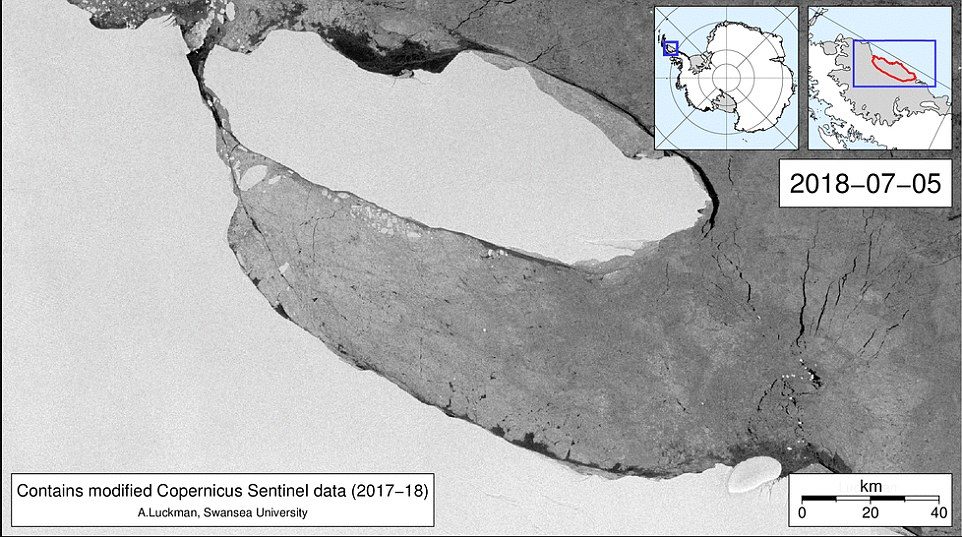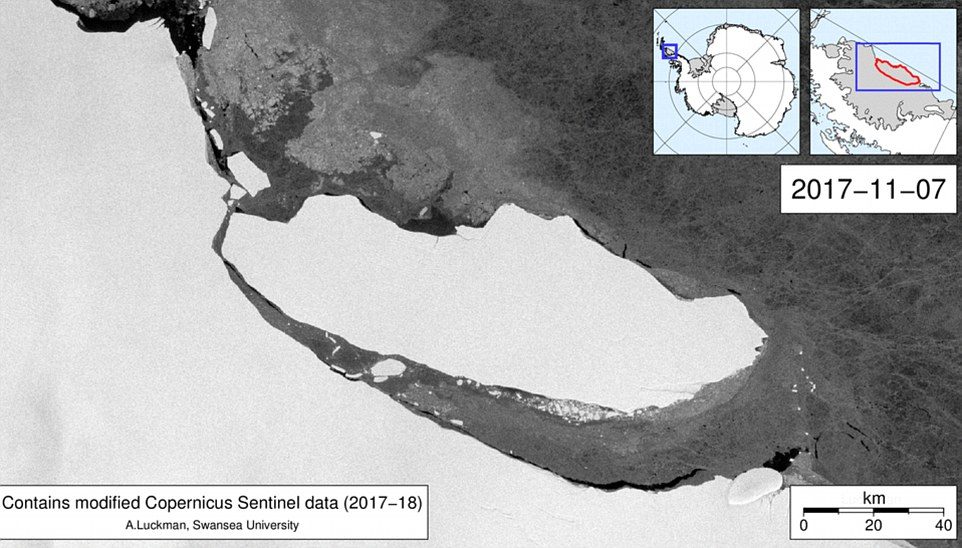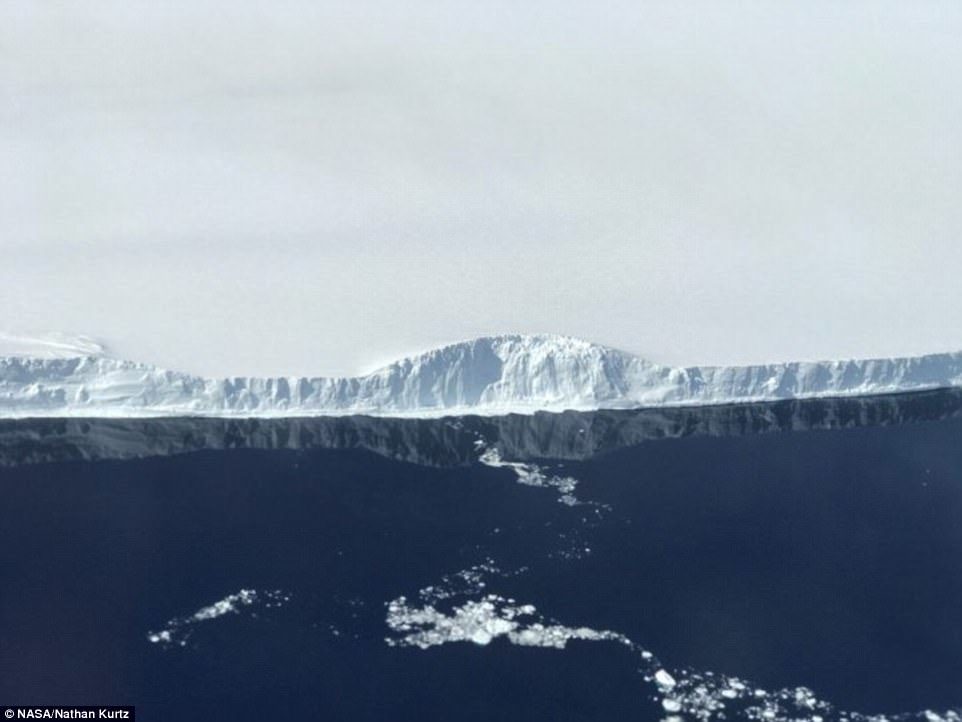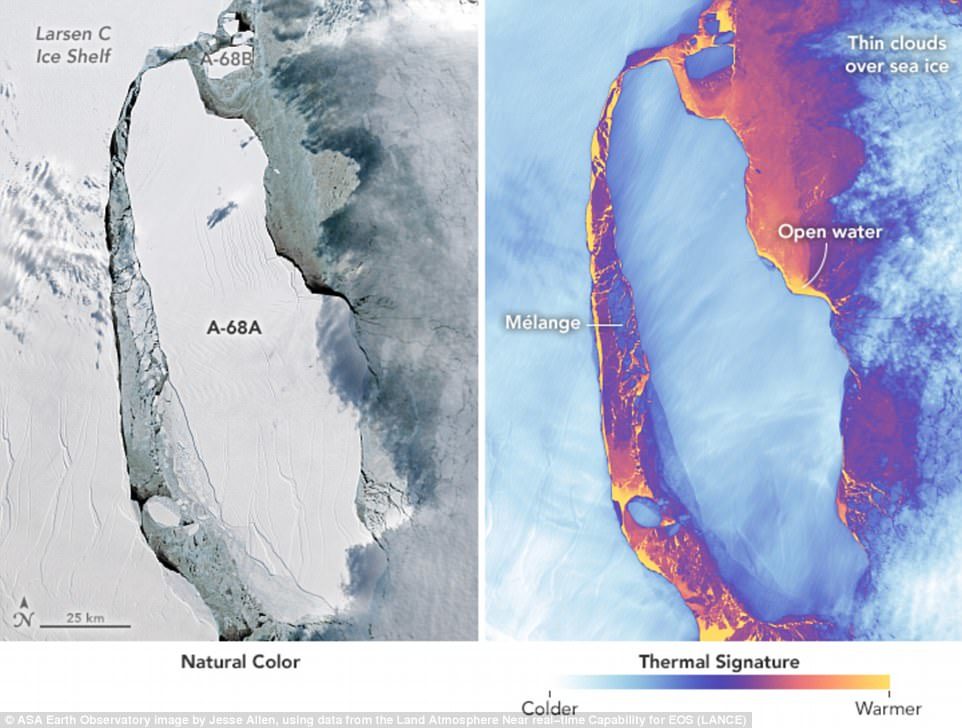
An animation showing its movement over the last few months reveals how the trillion-plus ton Iceberg A-68 has shifted as it's battered by ocean currents, tides, and winds in the Weddell Sea.
While the huge chunk of ice, estimated to be about the size of Delaware, has moved around some, the experts say its surroundings have kept it somewhat locked into place.
Iceberg A-68 is the sixth largest iceberg on record since scientists began keeping track, and its separation from the ice shelf sparked fears about its future impacts on global sea levels.
Despite all the activity in the Weddell Sea, 'its northern end has repeatedly been grounded in shallower water near Bawden Ice Rise,' according to Project Midas researchers, who have been monitoring the iceberg over the last year.

'Whilst not quite large enough to be given labels themselves, the total area of icebergs lost from A-68 in May was the size of a small city.'
When A-68 separated from Larsen C, it revealed an ocean hidden under the ice shelf for 120,000 years, and a team of scientists are now studying the region to uncover some of the hidden ecosystem's mysteries.
Led by the Cambridge-based British Antarctic Survey (BAS), the group will study tiny animals, microbes and plankton on the seafloor to see how they cope with severe changes to their environment.
As part of preliminary research for the trip, the team have taken aerial footage of the iceberg to monitor how far it has drifted to sea - the very first video captured of the berg since it calved from Larsen C last year.
Marine biologist Dr Katrin Linse, the BAS researcher leading the mission, said: 'The calving of A-68 provides us with a unique opportunity study marine life as it responds to a dramatic environmental change.
'It's important we get there quickly before the undersea environment changes as sunlight enters the water and new species begin to colonise.
'We've put together a team with a wide range of scientific skills so that we can collect as much information as possible in a short time. It's very exciting.'
The scientists are travelling by ship to collect samples from the newly exposed seabed, which covers an area of around 2,250 square miles (5,800 square kilometres).
They will also record any marine mammals and birds that might have moved into the area. Their findings will provide a picture of what life under the ice shelf was like so changes to the ecosystem can be tracked.
A-68 is 620 feet (190 meters) thick from top to bottom, with just 100 feet (30 meters) of it is visible above the ocean.

BAS researchers flew around the iceberg to get a better view of it as it drifts into the Weddell sea.
This newly exposed marine area is the first to benefit from an international agreement made in 2016 by the Commission for the Conservation of Antarctic Marine Living Resources (CCAMLR).
This agreement designates Special Areas for Scientific Study in newly exposed marine areas following the collapse or retreat of ice shelves across the Antarctic Peninsula region.
The agreement came following a European Union proposal to CCAMLR, led by BAS scientists.
Professor David Vaughan, Science Director at BAS, said: 'The calving of A-68 offers a new and unprecedented opportunity to establish an interdisciplinary scientific research programme in this climate sensitive region.
'Now is the time to address fundamental questions about the sustainability of polar continental shelves under climate change.
'We need to be bold on this one. Larsen C is a long way south and there's lots of sea ice in the area, but this is important science, so we will try our best to get the team where they need to be.'
Professor Stef Lhermitte, of Delft University in the Netherlands, shared satellite images of A68 on Twitter last year. The comparison shows a clear drift away from the Antarctic ice shelf.
WHAT IS THE A-68 ICEBERG AND WHAT CAUSED IT TO BREAK AWAY FROM ANTARCTICA?In July 2017, a huge crack in Antarctica's Larsen C ice shelf caused a trillion ton iceberg - the third biggest ever recorded - to break off from the icy southern continent.In July 2017, a huge crack in Antarctica's Larsen C ice shelf caused a trillion ton iceberg - the third biggest ever recorded - to break off from the icy southern continent. These detailed images were captured by instruments aboard Nasa's Landsat 8 satellite
The huge chunk of ice, dubbed iceberg A-68, measures 5,800 square kilometres (2,240 square miles), making it around the size of Delaware, or four times the area covered by Greater London.
Since A-68 broke away, it has remained unclear what will happen to the giant mass, with fears it could break up into pieces too small to track on satellite, and drift into shipping lanes.
Comment: When in fact it's so cold it hasn't broken up at all and is instead blocked by thick ice!
In July 2017, a huge crack in Antarctica's Larsen C ice shelf caused a trillion ton iceberg - the third biggest ever recorded - to break off from the icy southern continent. These detailed images were captured by instruments aboard Nasa's Landsat 8 satellite
Experts have found that cracks are still growing on Larsen C, and if they continue to grow, it's possible that the ice shelf could collapse.
If all of Larsen C collapses, the ice it holds back might add another 4 inches (10 cm) to global sea levels over the years.
Many scientists argue that a calving event was not necessarily due to climate change.
Instead, it may simply reflect the natural growth and decay cycle of an ice shelf.




Comment: At the time A-68 broke off from the Larsen ice shelf global warmists were decrying this as proof of warming, and yet there is so much sea ice that the ice berg hasn't moved very much. It's been a similar story with recent polar expeditions where sea ice was so dense that scientists, many convinced that soon 'children won't know what snow is', were unable to get to their destination. The question remains: Because we are seeing widespread cooling on our planet - at least above ground - what caused the ice shelf to break off in the first place? The cause could lie below, in the form of volcanic activity:
- Evidence of volcanic eruptions under Antarctic Ice
- Global warming... in the deeps: Tremendous geothermal heat source is melting Antarctic ice sheet from below
- Antarctica is even colder than scientists thought
And we can find other clues in the uptick in fissures we're seeing elsewhere on the planet: